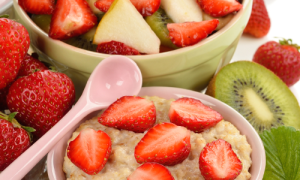MEDIA // ARTICLE

Foods That Keep You Fuller, For Longer
May 11, 2025 at 1:00 PM EST.Whether you’re trying to maintain a healthy weight or lose a few pounds, there’s one given element: You’re going to have to eat less. But being hungry all the time is the main reason many diets fail- and it can actually lead to you eating more, by binging when you’re hungry.
We’re here to tell you that you can satisfy your hunger pains without eating a ton of calories. It’s all about replacing, not limiting. Certain foods send signals to your brain that you’re full.
Let’s start with breakfast. Starting your day with eggs is one option for staying full until lunchtime. Research from the University of Missouri at Columbia shows that eating a 300-calorie breakfast made up of 30 to 39 grams of protein reduces hunger pangs and increases fullness. More than that, the study says people who eat a high-protein breakfast like sausage and eggs consume less calories throughout the day.
Another filling option for breakfast includes replacing cereal with oatmeal. Oatmeal keeps you feeling fuller longer. That’s according to a study in the Journal of the American College of Nutrition. Study participants were served 250 calories of cereal or oatmeal with 113 calories of milk. The people who ate oatmeal were fuller longer, and they also had less hunger and a decreased desire to eat compared to the cereal eaters. Oatmeal is high in fiber and protein, as well as beta-glucan. (Beta-glucan has been shown to lower blood cholesterol.)
One more morning option is to go Greek. In a Harvard study, researchers found that yogurt was the best food for dropping weight. Over time, people who eat a lot of Greek yogurt lost weight without trying. Greek yogurt contains twice the protein and less sugar than regular yogurt, which normalizes blood sugar and keeps you from feeling hungry longer.
If lunch is still a long way off, a mid-morning snack of nuts may help you eat less at lunch. In a British Journal of Nutrition study, women who ate either 1.5 ounces of peanuts or 3 tablespoons of peanut butter felt fuller for up to 12 hours more than those who didn’t eat the peanut products. Nuts control appetite because they’re rich in healthy unsaturated fat, protein and fiber. Together, the three nutrients slow digestion and regulate blood sugar when combined with healthy snacks like fruit, oatmeal or brown rice.
Let’s move on to lunch. Eating half an avocado with your lunch may help you feel full the rest of the afternoon. That’s according to a study published in Nutrition Journal. The study found participants who did felt more satisfied and had a lower desire to snack three hours later than on days they eat the same calories for lunch without the avocado.
Another good hunger-busting lunch tip? Starting off with soup. In a Penn State study, those who ate low-calorie, broth-based soup before their lunch entrees, reduced their calorie intake by 20 percent. Soups take the edge off your appetite since they take up so much space in your stomach, with very few calories.
After lunch, there’s a few tricks you can try to stay full until dinner time. Snacking on an apple about a half hour before a meal helps fill you up. Apples are full of fiber and water, helping you eat less during your evening meal. If you want to take it a step further, try drinking more water.
Being low on H20 can make your body think you’re hungry. The symptoms of hunger are similar to those of being dehydrated: low energy, bad mood and “sluggish” mind. If you find you get hungry mid-afternoon, try drinking a tall glass of water and waiting 10 minutes. You might find your hunger pangs pass easily.
When it comes to dinner, spicy foods may be the way to go. Many people know capsaicin, the “kick” ingredient in chilis, help ramp up metabolism. But recent research from Maastricht University in the Netherlands also found that adding ¼ teaspoon of chili pepper to each meal increased satiety and fullness.
Another dinner tip: Add superfoods like chickpeas, lentils, beans and peas. Called dietary “pulses”, they are the edible seeds of plants in the legume family. They’re are high in fiber, antioxidants, B vitamins and iron, and may also help control your appetite. A recent study published in the journal Obesity says people are 31 percent more satisfied after a meal when it included pulses.
Dinner may also be a good time to fill up on a food item that’s historically gotten a bad rap: the baked potato. They’re often rejected because they’re considered high in carbohydrates, but they’re actually a potent hunger buster. In a study that measured how filling 38 foods are, including brown rice and whole-wheat bread, people ranked boiled potatoes higher. They said they felt fuller and ate less two hours after eating them. Potatoes are full of vitamins, fiber and other nutrients that give you steady energy and a lasting feeling of fullness.
If you’ve made it all the way through dinner, but you’re craving something sweet late night, reach for dark chocolate. Research says dark chocolate not only helps reduce blood pressure, it also protects the heart and brain. It’s more filling than milk chocolate, and can satisfy cravings for both sweet and salty foods. Participants in a study from the journal Nutrition & Diabetes found they consumed 17 percent less calories at a meal following a dose of dark chocolate.
Making simple switches like dark chocolate for milk chocolate or cereal for oatmeal can be an easy way to quiet a grumbling stomach and feel satisfied all day long. Even several small changes can make you feel less like you’re dieting, and more like you’re just making healthy choices!
